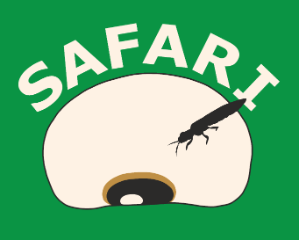SAFARI
Improving food safety by reducing pesticide residues: developing a pheromone alternative to insecticides for control of thrips on legumes in Kenya (“SAFARI”).


The SAFARI project is supported by a Global Challenges Research Fund (GCRF) Foundation Award for Global Agriculture and Food Systems Research, which is funded through the BBSRC. It runs from May 2017 to April 2019.
The aim of the project is to provide an alternative to insecticides for managing the bean flower thrips in cowpea and other similar crops in Kenya. This will reduce the amount of pesticide used and so improve food safety. It will also lead to higher yields, better safety for farm workers, reduced environmental impact and more sustainable agriculture.
The researchers
- Dr William D. J. Kirk (PI) (Keele University, UK)
- Dr Falko P. Drijfhout (Keele University, UK)
- Dr Matt O’Brien (Keele University, UK)
- Dr Tom Pope (Harper Adams University, UK)
- Dr Rob Graham (Harper Adams University, UK)
- Dr Sevgan Subramanian (icipe, Kenya)
- Dr Amanuel Tamiru (icipe, Kenya)
Further information
Cowpea (Vigna unguiculata) is rarely eaten in the UK, but it is a major crop across Africa south of the Sahara, where it is estimated that 38 million households (194 million people) grow it and harvest a total of 6 million tonnes per year. Cowpea is mainly grown by smallholder farmers and is an important source of protein to the urban and rural poor who cannot afford meat, fish or milk products. Unfortunately, many smallholder farmers apply chemical insecticides too frequently while struggling to control pests, so that crops for domestic consumption often contain unacceptably high levels of pesticide residues. In contrast, produce for export to Europe is required to have minimal residues, so access to pesticide-free produce is not equitable.
The main pest of cowpea in Kenya is the bean flower thrips (Megalurothrips sjostedti), which is a very small insect that breeds fast and is resistant to many insecticides. Smallholders end up spraying the crop repeatedly with insecticides, and this misuse and overuse by smallholder farmers has negative consequences for local consumers, particularly as cowpea is a staple food.
Male thrips form aggregations for mating. They do this by releasing special chemicals (pheromones) that attract males and females. Keele University and icipe (the International Centre of Insect Physiology and Ecology, Kenya) have previously identified two male-produced chemicals in the bean flower thrips and preliminary experiments show that they attract males and females. We will synthesise these chemicals and then test them in the laboratory and in crops to understand how they affect thrips behaviour. We will then exploit the pheromone in various ways to develop a control method for the bean flower thrips. The use of the pheromone will be developed to attract large numbers of thrips to sticky traps for mass trapping and to disrupt and prevent mating. Another approach we will test is the use of the pheromone to attract thrips away from the crop to areas that can be spot-sprayed with insecticide. Although this still uses insecticide, it uses far less and it is not sprayed on the crop, which avoids residues. We will also develop the use of the pheromone for a method known as “lure and infect” in which we will attract thrips to a device where the thrips pick up spores of a naturally occurring fungus that kills thrips. The thrips then disperse with the spores and spread them to other thrips on the crop.
The research is a collaboration between Keele University, Harper Adams University and icipe, with support from Real IPM Co. (Kenya) Ltd.

